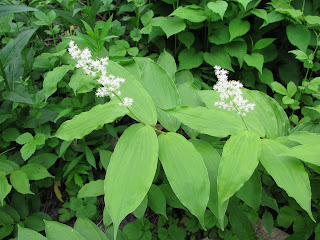
Garlic Mustard (
Alliaria petiolata) showing flowers, seeds and leaves
A few years ago I wrote a blog post called the
Top 5 Threats to the Don. At the time I thought that each of these would make a good post but I soon realized that they all were much larger and complex than could be fit into a single post. The second item, non-native invasive species is one of these complex items. I thought that this year I would try to tackle this item as a photo essay about individual species. This is the first of these posts.
Garlic Mustard (
Alliaria petiolata) is a non-native invasive plant species that is one of the problem species in the Don Valley. Actually it is causing problems throughout southern Ontario but it grows especially well in disturbed conditions of which the Don has more than enough such places.
Introduced from Europe as an edible herb, it has escaped cultivation and has invaded our natural areas. It grows in a variety of light conditions from full sun to shady forest understory. It is found in all types of soil except for very wet conditions. Garlic mustard is a biennial meaning that it lives for two years. In the first year a low basal rosette of leaves grows and it remains green throughout the fall and winter. In the following spring the plant grows a stem and flowers. Plants can range from a few centimetres to about a metre in height. It produces small four petaled white flowers which is a characteristic of the mustard family. Soon after flowering, seed pods emerge which first appears as thin green sticks standing upright around the flower stalks. Each seed pod can contain up to 20 seeds. A large plant can produce hundreds of seeds.
In addition to producing plentiful seed, the seeds that it does produce can remain viable for up to 11 years in the soil so that makes it very hard to get rid of it. Animals like deer who naturally feed on forest plants are not used to Garlic Mustard and avoid it, eating other native plants. This creates a positive feedback loop which allows Garlic Mustard to spread even faster.

First year Garlic Mustard rosette in early spring
If all this isn't bad enough, it turns out that garlic mustard is
allelopathic. In other words, the roots produce a toxin which kills soil fungi. Many native plants have formed symbiotic relationships with a group of fungi called
mycorrhizae. These organisms wrap tiny tethers called hyphae around the roots of plants. The hyphae gather water and nutrients from the soil and transfer it to the plant. In exchange the plant trades sugars and starches gained through photosynthesis for water and nutrients that the fungi collects. When these soil fungi are removed, this inhibits the growth of native plants in our ecosystem.
Another problem that has been noticed is that in areas of abundant garlic mustard tree seedlings are not as successful as they should be. Garlic mustard seems to inhibit their growth. This combination of hardiness, plentiful seed production, allelopathy, and ecosystem effects means that Garlic Mustard can soon overwhelm a natural site and become the dominant species. In some cases the only species growing is Garlic Mustard.

Forest understory in the lower Don Valley. 99% of the plants on the ground are Garlic Mustard
Garlic Mustard is not just limited to parks and ravines. It is also making its way into gardens. What can be done about this nasty invader? Hand pulling is the recommended method. To remove it grasp it tightly as close to the ground as possible and gently pull. Try to get as much of the root as possible because some root fragments have been known to resprout. The roots are not that deep and should be easy to pull out intact.
If you want to help protect our natural areas from this plant and others like it you can join one of the the city's
Community Stewardship teams. This volunteer program runs during the spring and summer and helps to protect some of the Don's more important natural areas. Teams meet once per week and remove Garlic Mustard and other non-native invaders.

Roots of a typical plant
Discard the plant into the regular garbage or the kitchen green bin. Don't put it into your garden composter because it will only become contaminated with Garlic Mustard seeds. For large amounts you can put them into a yard waste bag for city pickup.






















































